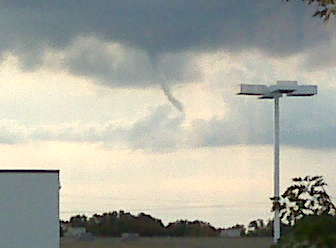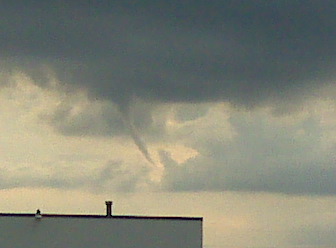ScienceDaily (July 7, 2008) — In an article published in the journal Science, a group of former senior federal officials call for the establishment of an independent Earth Systems Science Agency (ESSA) to meet the unprecedented environmental and economic challenges facing the nation. They propose forming the new agency by merging the National Oceanic and Atmospheric Administration (NOAA) and the U.S. Geological Survey (USGS).
Charles Kennel, former Associate Administrator of the National Aeronautics and Space Administration and Director of Mission to Planet Earth, says, "Earth system science focuses on understanding current processes and predicting changes that will take place over the next hundred years. It merges earth, atmospheric, and ocean science into a panorama of the earth system as it is today and as it will be tomorrow. We need it to predict climate change and its impacts, and to help us mitigate and adapt to other changes that have the potential to affect our quality of life and economic well-being."
The article points to the many scientific advantages of linking the atmospheric and marine programs of NOAA with the terrestrial, freshwater, and biological programs of USGS. Former NOAA administrator D. James Baker and former USGS director Charles Groat, among the seven coauthors of the paper, see important synergies in linking the two agencies.
According to Baker, "Population pressure, development impact, and resource extraction affect land and sea alike. Just as the science of the Earth is seamless, so should the government responsibility be merged for these separate Earth agencies."
Groat points to the breadth of capabilities the agency would possess. "The USGS, in bringing not only its geologic, biologic, hydrologic and geospatial expertise to the understanding of natural systems, but also its research capabilities in energy, mineral, water, and biologic resources, gives the new organization a comprehensive perspective on both environmental and resource systems. If we effectively link these capabilities with those of NOAA, we will have a powerful research institution," he says.
The authors express concern that federal environmental research, development, and monitoring programs are not presently structured to address such major environmental problems as global climate change, declines in freshwater availability and quality, and loss of biodiversity.
According to Donald Kennedy, former commissioner of the Food and Drug Administration and past president of Stanford University, "It isn't often that we are offered a real opportunity to make government work better. But the modest, sensible reorganization proposed here brings a new science-rich focus on some of our biggest contemporary challenges."
Kennedy also stresses the importance of linking ESSA's activities with the tremendous talent in the nation's universities.
The authors recommend that no less than 25 percent of the new agency's budget be devoted to grants, contracts, and cooperative agreements with academic and nonprofit institutions.
ESSA's success will also hinge on the collaborative arrangements the agency makes with other federal departments and agencies. According to former presidential science adviser John H. Gibbons, "ESSA's effectiveness will depend upon the bridges it builds to other federal agencies, from the National Aeronautics and Space Administration and National Science Foundation, to the Department of Energy and U.S. Environmental Protection Agency."
David Rejeski, who worked in both the White House Office of Science and Technology Policy and the Council on Environmental Quality, emphasizes the importance of setting aside some of ESSA's budget to fund research and development with breakthrough potential. "The Defense Advanced Research Projects Agency has demonstrated the value of funding high-risk, high-reward research and development. ESSA should foster similar ventures in the environmental arena," Rejeski says.
The paper points to the direct link between research and development and economic growth. The work of NOAA and USGS already fuels a large, multi-billion dollar private sector enterprise.
Mark Schaefer, a former official at the Department of the Interior and the White House science office, adds that "the quality of life of future generations will be defined by the quality of the environment we hand down to them. Our nation's research and development enterprise must be better structured and directed if we are to have any chance of solving the tremendous environmental challenges of our time."
WEATHER NOTENWS Doppler Radar Detecting Cars
Atmospheric conditions were right early Tuesday morning across north central Illinois for the NWS doppler radar in Romeoville to be able to pick up on traffic on Interstate 55 and 57. The doppler radar typically measures the motions of rain and water droplets toward and away from the radar, just like how a police officer's radar can pick up on a car's speed. But when a low level inversion (a layer of warmer air up above the surface) develops, it can cause the beam to be re-directed toward the ground and pick up on dense objects like buildings or traffic on highways. In this instance, the radar was able to pick up on traffic across Livingston County along I-55 as well as Iroquois County along I-57.
The specs of higher returns are where the beam is being deflected back to the radar off of traffic. It may be hard to make out, but the green and blue specs along I-57 near Danforth show some in-bound velocities of 115 knots (~130mph)...hopefully this was just noise and not someone driving too fast!!! Click here for more information on how doppler radar works.
To view images :NWS Doppler Radar Detecting Cars
LANDSPOUT SIGHTED LOWELL, INDIANA!On 12 August 2008 at around 6:50PM in Lowell, Indiana there was a confirmed funnel cloud sighted. However there was no meso effect or severe wx system on radar. The funnel lasted around 10 minutes, but never touched the ground. There was no danger. KLOT has recorded this funnel as a "landspout"! WGN 9 Meteorologist Tom Skilling sent these pictures to KLOT.


MARITIME NOTE
| Coast Guard investigates Midnight fire and sinking |
| Written by Jeff Walls | |
| Thursday, July 03, 2008 | |
| MOUNT DESERT — The sinking of the fishing vessel Midnight off of Mount Desert Rock is under a routine investigation by the United States Coast Guard. David and Ryan Graves of Northeast Harbor abandoned the boat when it caught fire and began to sink about 20 miles offshore on June 17. The father and son escaped, but due to communication problems were not rescued from their life raft until roughly four hours after the boat went down. “We are doing an investigation but it is not a negative one by any means,” said Lt. Jason Smilie from Coast Guard Sector Northern New England on June 27. “It is more data collection to find out what actually happened and if everything in response happened the way it should have, if the lifesaving devices worked, like the life raft and things like that.”According to early information, hydraulic fluid had somehow made its way on to either the engine, transmission, or exhaust, and caught fire. Ryan Graves said in his cell phone call to fellow fisherman Chris Candage that the boat had lost steering just prior to the fire being noticed. “We do know that there was some hydraulic oil that was in the vessel that had leaked out that was noticed in the area,” said Lt. Smilie. “We are not hanging our hat on that as the cause, but something caused the vessel to burn.” “What they are looking into is putting everyone’s statements together and trying to figure out what the final outcome is,” Lt. Smilie said. “Hydraulic fluid and a hot engine, that would be an ignition source, but we don’t know for sure.” An emergency position indicating radio beacon (EPIRB) was required for this vessel according to Lt. Smilie, but they are not foolproof. “I believe there was an EPIRB on there. An EPIRB is one of those types of instruments where when it goes under water it floats free,” Lt. Smile said. “Water completes the contact and allows it to transmit. If there was a fire on board, then the fire could have gotten to it before the water did,” he said. “We don’t have any sort of automatic fire release that would jettison it or anything like that.” As to why they crew didn’t call for help on VHF radio or manually activate the EPRIB, Lt. Smilie said, “The fire happened quickly and I am quite sure they were thinking ‘lifesaving’ just like anyone else because they don’t want to perish in the vessel.” He said several things made the sinking different. “Visibility was definitely an issue that day,” Lt. Smilie said. “Communications were also a problem. The distress came out on a cell phone and the cell phone service, especially on the ocean, is spotty.” The Coast Guard is still trying to find the exact location of Midnight. “When the Coast Guard found them they noted that there was debris floating in the water,” said Lt. Smilie. “So that with the location of where they were found and the time frame they have a general area of where it is.” |
RS

















![Validate my RSS feed [Valid RSS]](valid-rss.png)
No comments:
Post a Comment